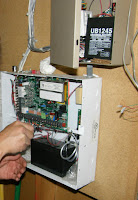I ran across the following videos on fire alarm testing and inspection and thought I'd add them to this article on the ESC website. ESC believes it's important that our clients fully understand what must be done and why we do it. These videos will give you a good idea about both. Sometimes it may see redundant that we have to do this on such a regular basis, but your fire alarm system is an important part of your safety program. Without a working system, lives could be lost.
The second video is a training video on a specific fire alarm panel, a Notifier 3030 system. The value of this video is the general explanation of how fire alarms work, what the various devices are called, and what to do under certain conditions. It's a good, general training video that I believe can make a huge difference in your understanding of fire alarm systems and the issues surrounding testing and inspections.
The remainder of this article pertains to frequency of testing and inspection:
As most facility managers know, there are fire codes at the local, state, and national level that require the testing and inspection of all fire alarm systems installed in commercial and government settings. The following test and inspection frequency chart comes from information contained in the National Training Center (NTC) Chuck Notes publication. For more information on NTC, go to: http://www.nationaltrainingcenter.net/index.xml.
Remember, only qualified, licensed fire alarm technicians are authorized to test fire alarm devices and systems. Inspections can be performed by end users, but you must adhere to strict guidelines set forth by the National Fire Protection Association (NFPA) of Quincy, Mass. per NFPA Chapter 10.
| ||||||||||||||||||||||||||||||||||||||||||||||||
TpromoCom


 Good morning!
Good morning!
 Home smoke alarms, also called single- and multiple-station smoke alarms, should be, by National Fire Code (NFC), replaced every 10 years.
Home smoke alarms, also called single- and multiple-station smoke alarms, should be, by National Fire Code (NFC), replaced every 10 years.

 Never before has the need for integrated systems in both private and public sectors been so great. In fact, system integration is the glue that gives today’s high-tech security the ability to do so much more with far less than in the past. And, because of network technology, a fully integrated building can save you money because it more often includes energy management.
Never before has the need for integrated systems in both private and public sectors been so great. In fact, system integration is the glue that gives today’s high-tech security the ability to do so much more with far less than in the past. And, because of network technology, a fully integrated building can save you money because it more often includes energy management.